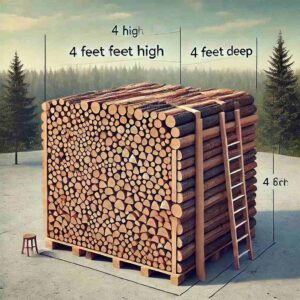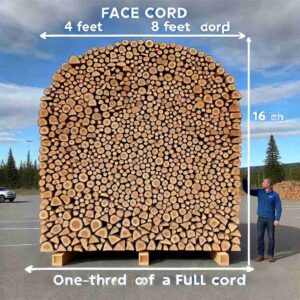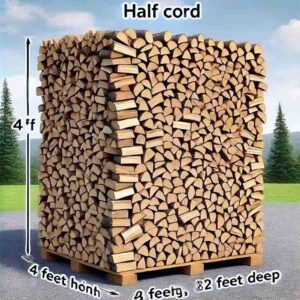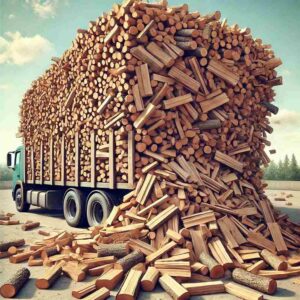If you’ve ever purchased or stored firewood, you’ve likely heard the term “cord of wood.” But what exactly does it mean? A cord is the standard unit of measurement for firewood, ensuring you know how much wood you’re getting. Understanding cords, their dimensions, and related terms can save you money and help you choose the right amount of firewood for your needs.
What Is a Cord of Wood?
A cord of wood is a tightly stacked pile of firewood measuring 128 cubic feet. This standard measurement ensures consistency in firewood sales and purchases. It’s often arranged as a stack that’s:
- 4 feet high
- 8 feet long
- 4 feet deep
This dimension is based on the assumption that the logs are neatly stacked with minimal gaps. However, the actual volume of usable wood can vary depending on how tightly the wood is packed and the size of the logs.
Types of Cords
Full Cord
A full cord is the standard 128 cubic feet of firewood. This is what most suppliers refer to when advertising firewood by the cord. Below is an image of a full cord of wood, showing the standard dimensions to help you better visualize it.

Face Cord
A face cord (or rick) is smaller and typically measures 4 feet high, 8 feet long, and 16 inches deep. It’s essentially one-third of a full cord and often used by those with smaller storage spaces or less frequent firewood needs. Below is an image of a face cord of firewood so you can have a better idea of what you getting.

Half Cord
As the name suggests, a half cord is half the volume of a full cord, measuring 64 cubic feet. It’s ideal for those who don’t need large quantities of wood but still want a manageable supply. Here’s an stacked image of a half cord of firewood which is half the volume of a full cord, perfect for those needing a more manageable supply.

Thrown Cord
This refers to firewood that’s loosely thrown into a truck or storage space, rather than neatly stacked. A thrown cord usually contains less usable wood than a stacked cord due to the gaps between pieces. Below is an image of a thrown cord of firewood.

Heating Value of a Cord of Wood
The heating value of a cord of wood depends on the type of wood and its moisture content. Hardwoods generally provide higher heat output than softwoods due to their density.
Heat Output by Type of Wood
- Hardwoods (Oak, Hickory, Maple): Burn hotter and longer, providing approximately 24–30 million BTUs per cord.
- Softwoods (Pine, Cedar): Burn faster and produce less heat, offering around 15–20 million BTUs per cord.
Impact of Moisture Content
- Seasoned Wood: With moisture content below 20%, seasoned wood burns efficiently, maximizing its heating value.
- Green Wood: High moisture content reduces heat output as energy is wasted evaporating water, leading to inefficient burning and excessive smoke.
Heating Efficiency
One full cord of seasoned hardwood can provide enough heat to sustain a small home for about a month in cold climates. For larger homes or inefficient stoves, you may need more cords to meet your heating needs.
How Much Firewood Is in a Cord?
The exact amount of firewood in a cord depends on the size and shape of the logs, as well as how tightly they’re stacked. For example:
- Small, uniform logs create a denser stack, resulting in more usable wood.
- Irregular or large logs leave more gaps, reducing the amount of wood within the same space.
Typically, a full cord contains around 85–90 cubic feet of actual wood, with the remaining space taken up by air gaps.
How Much Does a Cord of Wood Cost?
The price of a cord of wood varies depending on factors like location, type of wood, and whether it’s seasoned or green. Here’s a general price range:
- Softwood Cord: $150–$250
- Hardwood Cord (Seasoned): $200–$400
- Kiln-Dried Hardwood Cord: $300–$600
Prices tend to be higher in urban areas or during peak winter months when demand increases.
Common Uses for a Cord of Wood
A full cord of wood is a substantial amount and is often used for:
- Heating Homes: One full cord can typically heat a home for a month or more, depending on the climate and stove efficiency.
- Recreational Fires: Fire pits and campfires may use smaller portions of a cord, making face cords or bundles more practical.
- Cooking: Pizza ovens and smokers benefit from hardwood cords for consistent heat and flavor.
How to Stack a Cord of Wood
Proper stacking ensures your wood seasons effectively and remains dry:
- Choose a Level Surface: Use pallets or cinder blocks to keep wood off the ground.
- Stack Neatly: Align logs tightly to minimize gaps and maximize usable space.
- Cover the Top: Use a tarp to protect against rain or snow, but leave the sides open for ventilation.
How Long Does a Cord of Wood Last?
The lifespan of a cord depends on how often you burn wood and the efficiency of your stove or fireplace. On average:
- Daily Heating: A cord may last 4–6 weeks during winter.
- Occasional Use: For recreational or supplemental heating, a cord can last an entire season.
360 Key Takeaways
- A cord of wood measures 128 cubic feet, typically stacked 4x8x4 feet.
- Common types include full cords, face cords, and half cords, catering to different needs.
- Hardwoods provide higher heat output than softwoods, making them ideal for heating.
- Proper stacking and storage ensure your wood stays dry and ready to burn.
Final Thoughts
A cord of wood is a standard, reliable measurement for firewood that ensures you get what you pay for. Whether you’re heating your home, enjoying a fire pit, or cooking with wood, understanding cords and their variations helps you choose the right amount and type of firewood for your needs. Proper storage and stacking will maximize its lifespan and efficiency, giving you the best value for your investment.
